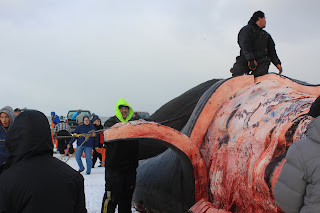 Welcome to Barrow, Alaska. The most northern land point in the United States (320 miles north of the Arctic Circle) and one of the most northern towns in the entire world. Nearly 4,000 native and non-native Alaskans live in Barrow along the Arctic Ocean where temperatures stay below freezing from early October to late May. During summer months the sun remains in the sky, providing 24 hours of daylight; however, in the wintertime the sun sets below the horizon and isn't seen for more than 2 months.
Welcome to Barrow, Alaska. The most northern land point in the United States (320 miles north of the Arctic Circle) and one of the most northern towns in the entire world. Nearly 4,000 native and non-native Alaskans live in Barrow along the Arctic Ocean where temperatures stay below freezing from early October to late May. During summer months the sun remains in the sky, providing 24 hours of daylight; however, in the wintertime the sun sets below the horizon and isn't seen for more than 2 months.The Inupik people have retained their native culture and language. Their heritage is centered around 12 core Inupiat values, one is hunting traditions. Elders teach their children about hunting for arviq (whale), tuttu (caribou), keviq (seal) and gathering kavirliq (cranberries). Every spring their people load their hand-carved boats onto sleds and begin pushing them across the pack ice to open water. A crew of four to eight men then paddle out to sea in search for the great Bowhead Whale, a centerpiece of the culture, traditions, and their main source of food.
Subsistence hunting and gathering are these people's means for living off the land, taking only what they need for survival. Their ancestors have taught them respect for the land, sea and animals. Taking a whale is extremely spiritual ritual. They say the whale can see the Inupiat's kindness and will sacrifice itself for a village and will allow the people to hunt it. Once the whale is taken, the whale's spirit is kept alive as a bright flame within a lamp tended to by an innocent girl. The Inupiats keep this flame alive so that the whale spirit may tell other whales of the people's kindness and its good treatment, persuading other whales to sacrifice themselves to the village in following years.
Since 1982, there has been a moratorium on whale hunting (with the exception of highly regulated hunting by indigenous people). The whale population was devastated by commercial whaling. Today many environmental agencies provide research for establishing appropriate quotas for the Inupiat hunters to follow. During this fall whaling season Barrow is allowed to take 12 whales (Estimated bowhead population is 12,000+). Other Inupiat villages are allowed smaller quotas or sometimes only allowed to hunt in spring or fall but not both.

The whales range in size from 20 to 50 in length. The largest have been recorded to weigh just over 100,000 pounds. It takes an entire village to move the whale out of the water and begin cutting the maktak (skin and blubber) into slices for storage. It is extremely healthy to eat every part of the whale except the liver. Even the remains are not wasted. some is turned into dog food or else hauled out of town for the Nanuq (polar bears) to eat.
Eating a diet rich in subsistence foods is extremely healthy. The all natural diet contains the correct amount of proteins and fats as well as adequate vitamins and minerals. Fish and whale are high in omega-3s and iron and berries have high amounts of vitamins A and C and plenty of fiber. The Inupiats absorb a majority of their vitamin D from their fish, a benefit when the sun is absent for most of the winter. Prior to encounters with Caucasian people, the Inupiak Eskimos had some of the lowest rates of cancer, diabetes and obesity in the world. But after being introduced to cigarettes, alcohol, processed foods and soda, the Inupiak way of life and good health are drastically different. These people are loosing their way of life and whaling is all they have left.

Subsistence hunting and gathering are these people's means for living off the land, taking only what they need for survival. Their ancestors have taught them respect for the land, sea and animals.
ReplyDeletelimelight winter collection 2021 stitched
limelight stitched 2021